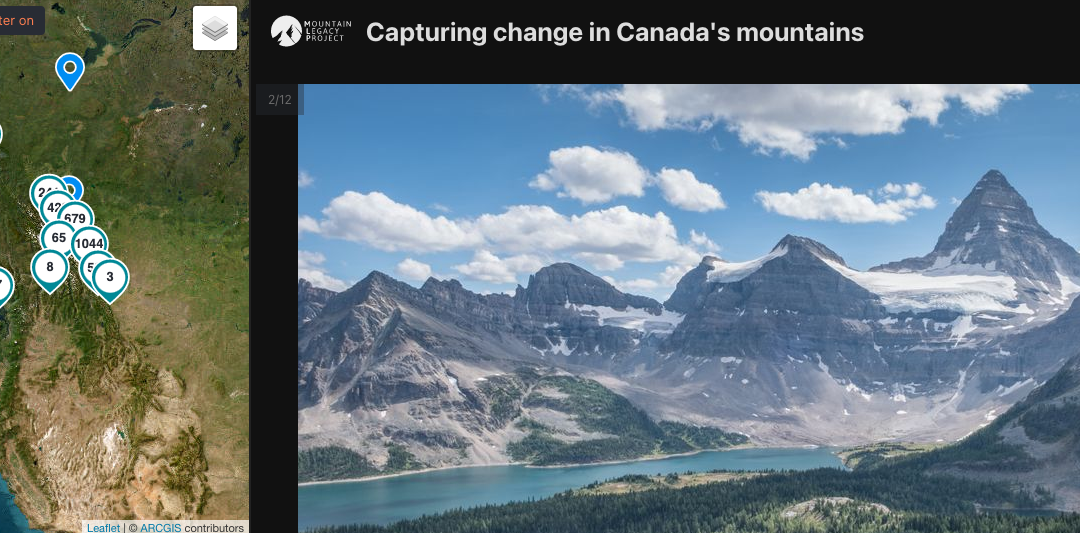Eric Higgs, Mar 1, 2022
The Mountain Legacy Project launched a brand new Explorer tool. Building on our previous public-facing website it is a future-oriented platform for serving up images and information about the world’s largest systematic collection of mountain repeat photography.
I invite you to check out: explore.mountainlegacy.ca
Here are a few of the powerful new features:
- Comprehensive search functions
- Wide availability of metadata and image versions
- Multiple map backgrounds
- Accounts (by request) that allow collaborators access to hi-res imagery
- A list view for advanced users

Perhaps the biggest changes are behind-the-scenes. Beginning in 2018 I met with Stewart Arneil and Greg Newton at UVic’s Humanities Computing and Media Centre to discuss how to move into the next decade of digital work with the Mountain Legacy Project. We had three aims. First, it was important to bring Explorer into compliance with best practices for large databases. Second, we needed a more secure infrastructure. And, third, we wanted an extensible tool, one that could accommodate new initiatives and needs.
We were fortunate to recruit Spencer Rose, an accomplished professional developer who had returned to UVic for a graduate degree in Computer Science. With critical financial support from the Canadian Mountain Network, we embarked on a 5 phase re-development sequence. Beginning with a comprehensive assessment of the digital infrastructure, he proceeded to build a new digital structure that integrated all of our services (shifting from a Ruby-on-Rails to a PHP framework). By Phase 3 (early 2021) we had the glimmer of a new tool. In the meantime, we had secured support from Belaid Moa’s amazing Research Computing Group at UVic, who connected us with the Compute Canada “Arbutus” cluster on Canada’s high-performance computing network. We ran software on virtual development servers before finally turning these over to production recently. All of our digital assets—100s of thousands of files—were moved to Compute Canada and served through dedicated (not third-party) cloud services.
It was a tremendous effort to reconcile and rebuild our digital services. We are now in Phase 4 of the redevelopment, with our “soft” launch in late 2021. A formal launch is planned with our major sponsor, the Canadian Mountain Network, in 2022. We anticipate further developments through 2023 and beyond.
The Mountain Legacy Project embraced digital access earlier than most. Twenty years ago, in 2002, we launched a web-based tool in collaboration with the SunSITE initiative at the University of Alberta. Sadly no longer functioning, bridgland.sunsite.ualberta.ca ran for more than a decade with advanced (for the time) features. It became a Computerworld Laureate award winner in 2003. A decade later, recognizing the significant expansion of our work, UVic Computer Science graduate student, Chris Gat, developed a powerful new tool (MEAT—Mountain Legacy Editing and Administering Tool) that provided a backend database driving a brand new public facing Explorer tool. Chris was a hero for developing these tools, and for remaining a dedicated contributor for more than a decade. RIP MEAT.
Looking into the future, we will continue to build our digital collections in collaboration with Library and Archives Canada / Bibliothèque et Archives Canada (LAC/BAC). We are looking to expand our collections to embrace diverse survey records. There are initiatives underway to examine how to decolonize a project fundamentally rooted in a colonial endeavour, and to support Indigenous interests. We are also aware of other mountain repeat photographic collections in Canada and elsewhere that may need a digital home. All the while we are looking for ways to secure the Mountain Legacy Project for the long term. We welcome your advice and support.
We also welcome your comments and engagement. We find new things to fix and update weekly. It helps us to know what works well and what could be improved. Please send comments to mntnlgcy@uvic.ca

